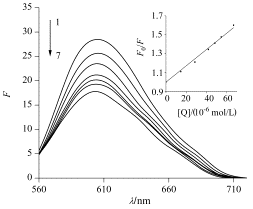[1] Kelly, E. H.; Anthony, R. T.; Dennis, J. B. J. Nutr. Biochem. 2002, 13, 572.
[2] Vitorino, J.; Sottomayor, M. J. J. Mol. Struct. 2010, 975, 292.
[3] Hu, C.; Kitts, D. D. J. Agric. Food Chem. 2003, 52, 301.
[4] Hu, C.; Kitts, D. D. Mol. Cell. Biochem. 2004, 265, 107.
[5] Spencer, J. P. E.; Chowrimootoo, G.; Choudhury, R.; Debnam, E. S.; Srai, S. K.; Rice-Evans, C. FEBS Lett. 1999, 485, 224.
[6] Baskar, A. A.; Ignacimuthu, S.; Michael, G. P.; AlNumair, K. S. Nutr. Cancer 2011, 63, 130.
[7] Zhang, Q.; Feng, W.-J.; Li, X.-D. J. Pharmaceut. Univ. 2010, 41, 555. (张强, 冯文军, 李晓冬, 中国医科大学学报, 2010, 41, 555.)
[8] Mello, L. D.; Pereira, R. M. S.; Sawaya, A. C. H. F.; Eberlin, M. N.; Kubota, L. T. J. Pharm. Biomed. Anal. 2007, 45, 706.
[9] Wang, L.-F.; Song, Y.-M.; Feng, Y.-F.; Zhang, Q.; Wang, Y.-Y. Acta Chim. Sinica 2004, 62, 2277. (王流芳, 宋玉民, 冯亚非, 张歧, 王印月, 化学学报, 2004, 62, 2277.)
[10] Wang, Z. F.; Cui, M.; Song, F. R.; Lu, L.; Liu, Z. Q.; Liu, S. Y. J. Am. Soc. Mass Spectrom. 2008, 19, 914.
[11] Nafisi, S.; Hashemi, M.; Rajabi, M.; Tajmir-Riahi, H. A. DNA Cell Biol. 2008, 27, 433.
[12] Qu, L.-B.; Zhao, J.-H.; Li, J.-J.; Yang, R. J. Instrument. Anal. 2008, 27, 79. (屈凌波, 赵俊宏, 李建军, 杨冉, 分析测试学报, 2008, 27, 79.)
[13] Wan, C. H.; Cui, M.; Song, F. R.; Liu, Z. Q.; Liu, S. Y. Int. J. Mass Spectrom. 2009, 283, 48.
[14] Li, H.-H.; Han, D.-W.; Yuan, G. Acta Chim. Sinica 2007, 65, 1543. (李卉卉, 韩德伟, 袁谷, 化学学报, 2007, 65, 1543.)
[15] Zhao, L.; Wu, B.-Y.; Gao, L.-H.; Wang, K.-Z. Acta Chim. Sinica 2006, 64, 1402. (赵琳, 吴宝燕, 高丽华, 王科志, 化学学报, 2006, 64, 1402.)
[16] Wang, Z. F.; Guo, X. H.; Liu, Z. Q.; Cui, M.; Song, F. R.; Liu, S. Y. J. Mass Spectrom. 2008, 43, 327.
[17] Keller, K. M.; Zhang, J. M.; Oehlers, L.; Brodbelt, J. S. J. Mass Spectrom. 2005, 40, 1362.
[18] Long, E. C.; Barton, J. K. Acc. Chem. Res. 1990, 23, 271.
[19] Animesh, P.; Sandipan, S.; Titas, M.; Ennio, Z.; Pabitra, C. Polyhedron 2011, 30, 2783. |
